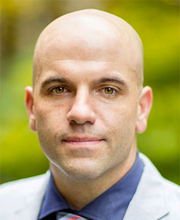Jim Pfaendtner

Staff Scientist, Pacific Northwest National Lab
Senior Data Scientist, UW eScience Institute
Steven R. and Connie R. Rogel Endowed Professor
Chemical Engineering
Professor
Chemistry
Pronouns: he/him
- jpfaendt@u.washington.edu |
- (206) 616-8128
- BNS 107
- Pfaendtner Research Group
Education
- Ph.D. Northwestern University, 2007
- B.S. ChE, Georgia Institute of Technology, 2001
Research Statement
Our group uses computer simulations to understand and control molecular scale driving forces for a wide range of applications spanning biotechnology to fuel combustion. We develop new methods that expand the capabilities of molecular simulation and use advanced research computing resources to solve challenging problems in the area of computational molecular science. A few representative projects are described below.
Molecular Data Science
Molecular Data Science research in the Pfaendtner group applies AI to the chemical engineering problems to aid in the discovery, design and characterization of new molecules and materials. We use statistical and machine learning methods, complex data visualizations, and advanced supercomputers in our work. Examples include using AI to learn from the rules of nature new ways to design polymer sorbents selective capture of small molecules to harnessing neural networks to uncover molecular fingerprints that help design new molecules for energy storage applications.
Complex Reacting Systems
Our research in complex reaction networks primarily focuses on the use of MD simulation to predict new reaction pathways when the chemistry is too complicated to enumerate by hand and/or there is insufficient knowledge to apply automated reaction mechanism generation tools. We use a variety of approaches to characterize reaction networks including statistical learning, enhanced sampling, and ab initio methods. Current areas of interest include applications in combustion, pyrolysis and reactions in the condensed phase.
Biomimetic Materials and Polymers
Our group studies a range of soft-matter systems ranging from synthetic polymers to biomimetic systems. For example, we seek to use computer simulations to unravel the atomic scale features of ion-diffusion in conjugated polymers for applications in bioelectronics and energy storage. We also study so-called sequence defined polymers that mimic biomaterials found in nature like peptides. One versatile class of materials are N-substituted glycines or peptoids. Working closely with experimental collaborators, we use computer simulations to understand fundamental kinetic and thermodynamic mechanisms related to peptoid self-assembly and structure-function relationships. This work requires careful development of empirical potentials (force fields) for molecular modeling as well as application of special simulation methods to increase the accessible length and time scales we can probe with our models.
Honors & awards
- UW College of Engineering Faculty Junior Innovator Award, 2014
- NAE Frontiers of Engineering Education Participant, 2013
- UW Presidential Distinguished Teaching Award, 2013
- ACS OpenEye Outstanding Junior Faculty Award, 2013
- NSF CAREER Award, 2012
- US National Academy of Science Kavli Fellow, 2012